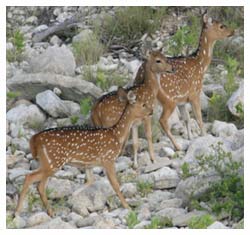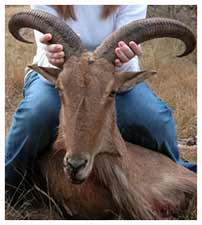Hunting Tips, Questions, Stories & Discussion
Focusing on managing Texas wildlife habitat and natural resources for native and exotic wild game species, for this and future generation of hunters and outdoor enthusiasts.Thursday, January 14, 2010
A Classic Texas Hill Country Axis Hunt!
My target of choice was the elusive aoudad sheep. Since several groups of these animals were spotted at Escondido Ranch earlier in the week, and with one being taken the prior morning, I was optimistic.
Given the prevailing wind, the best spot for seeing a group of aoudad this morning was near Ledge Blind, so called because of its proximity to an edge of a canyon. This ground blind can easily accommodate up to three hunters and its location makes it ideal for hunting everything from axis deer, to aoudad sheep, feral hogs and whitetail deer.
Once I got into the blind, settled in and chambered my .270 rifle, I eased back into a chair and waited. The sun began its ritual morning path and the feeder went off right on cue. Moments later, I spotted three mature whitetail does cautiously surveying the area from along the edge of the brush line. Although the season for whitetail does and whitetail spikes was still open, I could not see a good reason to ruin my chances at an aoudad by prematurely taking a whitetail doe. As the animals finally began to approach the feeder, the wind began to shift unfavorably. Being on the ground and in close proximity to these already weary animals, a whiff of an unfamiliar scent was enough to send the does pouncing back into the safety of the brush. I waited a few more minutes, but decided that given the change in the wind’s direction, it would be prudent to change my location. I grabbed my gun and a pair of binoculars, and started making my way down to the edge of Central Canyon towards the Ambush Blind.
Quietly weaving my way through the trees along a rocky, gravel covered slope, I came upon a large group of Rio Grande turkey hens. These birds were casually making their way through the underbrush even though I was standing no more than 15 yards from the nearest bird. In an effort not to disturb their progress and avoid scarring off any game which maybe grazing down in the canyon, I came to a stand-still hoping that the turkeys would pass…
After several minutes of resembling a statue, it became apparent that the turkeys were not in any hurry. While several of the closer hens kept looking in my direction, the rest of the flock kept picking at the semi-frozen ground and moving along at “a pace of a dying turtle”. I was already cold, so before I became permanently statuesque, I decided to try to move around the flock…huh, that did not work out. As soon as I made the first step, all hell broke loose! The turkeys noisily surged in all directions and up into the trees. The rustling of wings and auditory alarms were almost deafening in the morning’s quiet.
With a big sigh and a few select words, I proceeded down to the Ambush blind. Once I got down to the edge of the canyon near the blind, I surveyed the valley below. It was no big surprise that nothing was moving.
 I settled into a chair and closed my eyes. Not that I would not have enjoyed a few minutes of shut-eye, but the shape of this narrow canyon carried sounds so well that you could actually hear the animals moving before you could even see them. I listened for a few minutes and could only hear the chirping of the birds and distant squawking of turkeys. It was already edging past 8:40 am when I heard movement to my left. From the corner of my eye I saw three axis does make their way across the road, pausing for a bit and then disappearing into the brush on the other side. Although, at that point, I could no longer see the animals, I could clearly hear them making their way up the face of the canyon, opposite of my location.
I settled into a chair and closed my eyes. Not that I would not have enjoyed a few minutes of shut-eye, but the shape of this narrow canyon carried sounds so well that you could actually hear the animals moving before you could even see them. I listened for a few minutes and could only hear the chirping of the birds and distant squawking of turkeys. It was already edging past 8:40 am when I heard movement to my left. From the corner of my eye I saw three axis does make their way across the road, pausing for a bit and then disappearing into the brush on the other side. Although, at that point, I could no longer see the animals, I could clearly hear them making their way up the face of the canyon, opposite of my location.I knew that one of the guest hunters was interested in harvesting an axis doe, so I text him my whereabouts. While I awaited for a reply, I continued to scan the opposite side of the canyon for movement. As the rising sun illuminated the west side of the canyon, my side remained in the shadows. As the animals worked their way up the slope, they paused in clearings to bathe in the sunlight, which gave me the opportunity to see the axis while I remained unseen by them. Then the sudden vibration of my phone from the incoming message startled me. The text simply said “shoot one”.
A smile probably lit up my face. I reached for the gun. Spotting an axis about 250 feet up the canyon’s face and 170 yards away, I brought the scope to my eye and traced an upward path from the base of the slope. As I zoomed in, it became apparent that I was looking at a young axis buck (or a spike). I pulled away from the scope and gazed across the canyon wall. I could see nothing else in the few gravel covered spaces along the face. I leaned back towards the scope and reacquired the axis buck as it was moving along the ledge. It was then I spotted a partially hidden axis doe trailing the spike. Allowing the axis doe to clear the cover and step into the opening, I placed the cross-hairs behind the shoulder, removed the safety and squeezed… “BOOM” rang out and echoed back along the canyon’s walls.
Before the rising gun smoke obscured my line-of-sight, I could see the projectile’s impact as the stiffened animal toppled over to its side and slid several feet down before getting caught up in some vegetation. It was then that the opposite side of the canyon irrupted with movement, as 8 to 10 axis deer dashed from beneath the brush and over the top ridge of the canyon. Great camo! Even armed with 16x binoculars, it was impossible to spot the axis deer in the cover.
Giddy as a schoolboy, I picked up the cell and informed the other hunter that “dinner was served”. But before we could throw the back straps on the grill, someone would have to climb up the cliff to retreat the axis doe. A quick plan was devised; I was to stay put on my perch and direct the recovery crew to the place where the animal would have landed.
Within a few minutes of their arrival, a two men team successfully ascended the slope and recovered the deer. However, while on the way down I could not help but to overhear them complaining about me shooting animals too high up the cliff..., that I should really try to knock the animals off so that they simply slide down to the base… and next time, I should climb up and get them myself… Like I stated before, there are great acoustics in that canyon. Besides, they were just jealous!
Later, the two hunters thanked each other…one for the venison, and the other for an opportunity to make a memorable shot. Although my aoudad was still lurking in the shadows of Escondido Ranch terrain, this was a classic and no-less successful Texas Hill Country axis deer hunt!
Labels: axis doe hunting, texas aoudad hunts, texas axis deer hunts
Monday, June 22, 2009
I thought that these sheep did best in mountainous areas, how does that fit in for south Texas aoudad populations?
The south Texas Aoudad sheep are no less athletic than those that range into the mountains in Texas as well as New Mexico. The hill  country sheep are just as wily, alert and highly intelligent as those that live in the much more remote areas of the state. The south Texas Aoudads that live on managed game ranches often are slightly larger than the free range members of the species, plus they are not over hunted or decimated by extreme weather conditions or disease that can occur in wild herds.
country sheep are just as wily, alert and highly intelligent as those that live in the much more remote areas of the state. The south Texas Aoudads that live on managed game ranches often are slightly larger than the free range members of the species, plus they are not over hunted or decimated by extreme weather conditions or disease that can occur in wild herds.
Other than south Texas Aoudad sheep on managed game ranches or exotic game ranches, are there a lot in the wild?
For people that aren't used to the miles and miles of unfenced land in south and west Texas it may be surprising to know that most south Texas Aoudad sheep are actually on free range, not confined to a game ranches in the true sense. These game leases or ranches can run for literally hundreds of square miles of brush, rugged country and dirt roads. It is estimated that the original Barbary or Aoudad sheep that were brought over from Africa after World War ll quickly escaped from their fenced pastures and immediately began populating these huge grazing ranges and leases.
Based on different studies that include a lot of extrapolation from actual hard numbers, it is estimated by researchers that there are over 25,000 central, west and south Texas Aoudad sheep living in unconfined pastures and on grazing and hunting leases. The number of captive or contained Aoudad is not known, however they are likely to total at least another 10,000 or so animals.
What is the difference between shooting a male or a female south Texas Aoudad?
If you are looking for a lot of sporting opportunity there is really no difference between either the male or female when it comes to south Texas Aoudad hunts. In general the female is going to be lighter in total body weight plus she will not have the huge trophy horns that you could possibly get if you decided to go for a ram.
The females also don't have the distinguishing chaps, the heavy, long growth of hair on the front of the legs. Females don't have the highly prominent beard either, however they still make a terrific head mount or horn mount, your choice.
Labels: aoudad hunting, aoudad sheep hunting, texas aoudad hunts, trophy aoudad sheep
Archives
December 2008 January 2009 February 2009 April 2009 May 2009 June 2009 July 2009 August 2009 September 2009 November 2009 December 2009 January 2010 February 2010 March 2010 April 2010
Subscribe to Posts [Atom]
